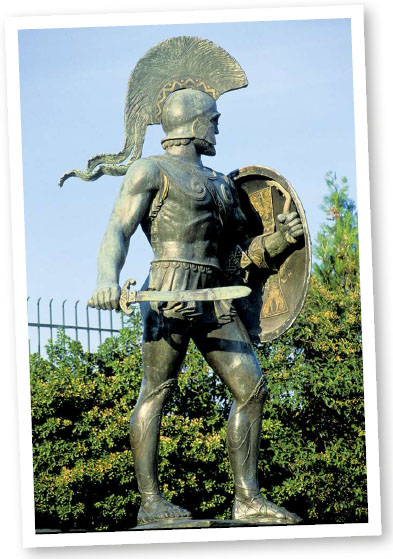300: the Battle of Thermopylae
The Battle of Thermopylae is seconds away, and Zack Snyder’s 300 prepares to explode into an hour of unapologetically blood-splattered action. A phalanx of 300 lone warriors from the Greek military state of Sparta faces hundreds of thousands of soldiers from every corner of the mighty Persian Empire, but, having trained for war their entire lives, they are unfazed by the impossible odds. Before shields clatter and spears are thrust, a Persian messenger offers a final chance to surrender. “Spartans!” he yells, “Lay down your weapons.” But the Spartan King Leonidas (played with gusto by Gerard Butler) takes pleasure in his retort: “Persians! Come and get them.”
It is a line that sounds like it could only have been written for an action movie and yet that dialogue is about 2,500 years old. The real Leonidas sent that response to the Persian King Xerxes before battle was joined in 480 BC. That serves to show the surprising thing about 300. As an ostentatious, stylised blockbuster, there is much that can be dismissed as historically suspicious or the victim of overly artistic license, but at its heart, the movie understands just how cinematic the actual battle was – and that Leonidas and his 300 Spartans were tailor-made to be action stars and, as it turned out, martyrs.
LIVE AND BREATHE WAR
In 480 BC, the Persian Empire was already the largest power base the world had seen, but Xerxes greedily eyed the independent city states that formed Greece as a stepping stone to expand into Europe. His father, Darius, attempted to invade a decade earlier but had been repelled at the Battle of Marathon, so Xerxes, determined not to make the same mistakes, spent years preparing a gargantuan army and fleet. Putting their usual rivalries aside, the Greeks united against this threat and knew their best chance of success was to fight on two fronts. At sea, they would block the Persians at the Straits of Artemisium, while on land, the ideal ground to defend was Thermopylae, or ‘Hot Gates’ (named after the hot springs there). With water to the east and mountains to the west, it was a narrow coastal track in northern Greece, which the Persian army would have to march through if they wanted to reach the southern states.
The Spartans, who lived and breathed war, were the natural choice to lead the land force. They were an elite fighting force of highly disciplined and seemingly fearless warriors, skilled with a number of weapons (except the bow, which they considered the weapon of cowards). From birth – where they are inspected for physical faults and discarded on a hilltop if deemed weak – the life of a man in Sparta was consumed by the army. While helots (‘slaves’) carried out everyday jobs such as farming, Spartans were in constant, brutal military training and drilled to believe that the greatest glory they could achieve was to die in battle. Such was Sparta’s readiness for war, the city had two kings so that one could maintain law and order at home while the other led the army.

This statue of Leonidas has stood in former Spartan lands since it was erected in 1968
GETTY X2, MOVIE STILLS X2
START YOUNG
Leonidas had to undergo the Spartan ritual of ‘agoge’ – at the age of seven, boys were entered into a military boot camp where they learned to fight, steal and tolerate pain. They could only enter manhood by killing a slave.